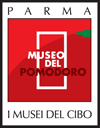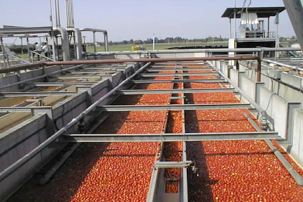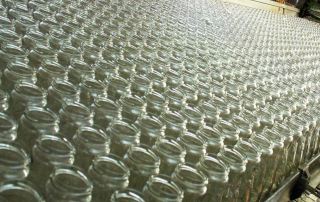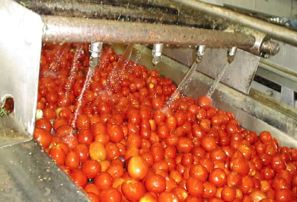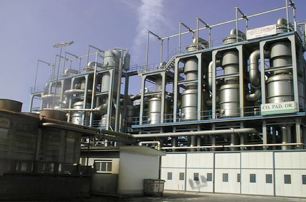The preparation of Tomato preserve
Selection and grading
Processing begins with the selection and grading of tomatoes and the elimination of unsuitable fruit and the pedicles.
Washing
This is carried out by dipping the tomatoes repeatedly into water filled tubs and rinsing them.
Scalding
Emerging the tomato in boiling water allows the skin to be peeled off. After scalding the fruit is drained.
Sifting or pressing
Using the appropriate machine which has a cylindrical sieve at one end, the tomatoes are inserted on one side and the squeezed juice and pulp pass through the sieve and fall into containers while from a second opening emerge the seeds and skins.
Pasteurisation
This is the most delicate phase of the production process and entails boiling the product for a variable period between 15 and 30 minutes. This procedure, in industry, takes place in a vacuum in the “boules” and then are passed to the concentrators.
Canning or packaging
The concentrated product thus obtained is inserted in containers of glass, metal or cartons and then sealed. In domestic production basil and olive oil can be added to keep the preserve from contact with the air. The industrial product is sterilised after packaging, unless this has been done in an aseptic environment.
Preserving treatment
This treatment allows the containers to be gradually brought to room temperature. Following this treatment the containers can be moved, stored, packaged up and sent to their destinations.
Tomato processing
Industrial production steps
by Emilia Valli
The tomato has diuretic and appetite stimulating properties as well as being refreshing and mildly laxative, but it is poor in sugar and fats. Tomato juice
freshly squeezed and drunk in the morning fights chronic constipation and brings relief to the problems associated with kidney stones; it is an excellent tonic and is useful to fight rheumatism and gout. Furthermore, tomatoes facilitate the digestion of food containing starches and flour. The tomato is an excellent activator of gastric motility and resolves problems of slow digestion with scarce gastric acid. For the same reason it is not advisable for those who suffer from ulcers or gastritis, and is also not indicated for those who have dermatological problems. As it is rich in sulphur, the tomato has a de-toxing effect, and because of its agreeable smell manages to stimulate the appetite.
The tomato is basically made up of water (93-96%) and the rest can be broken down into sugars(2-3%), acids (malic 50%, citric 10%, minimum traces of ossalic acid), insoluble substances (pectine, cellulose,…..) amino acids and soluble proteins, salts, vitamins.
The tomato is a true concentrate of beneficent substances: vitamins C and A, but also B1, B2, B6, E, H, K, and PP. The 24% of vitamin C has an important anti infection role, it intervenes in growth processes and prevents cellular oxidation, but, given the fragile nature of the vitamin, it is lost in the cooking process. Vitamin C is one of the most valid means of preventing and curing colds and infections generally. Vitamin A, present in the tomato in the measure of 0.7% is useful in maintaining skin structure, it also helps sight, nails and hair, bone and gums preventing and even curing tooth decay. The vitamin B content is also relevant as it favours cell renewal and oxygenation.
Fresh tomato is thus an elixir of good health in Summer both for the vitamin and salt content which is easily eliminated by sweat glands in the heat.
For the same reason, the tomato is particularly indicated in middle age for its potassium content, which helps the organism to re-establish its water balance, and for the quality of the sugars (fructose, glucose and an insignificant presence of saccarose).
The nutritional value of the tomato varies, naturally, with its degree of ripeness, and, obviously, the healthiest ones are also the freshest.
Average values for 100 g of tomatoes
Potassium
200-300 mg
Chlorine
30-60 mg
Phosphorus
27 mg
Calcium
11 mg
Iron
0,6 mg
Magnesium
tracce
Vitamin C
24 mg
Vitamin A
0,7 mg
Vitamin PP
0,5 mg
Vitamin B1
0,06 mg
Vitamin B2
0,04 mg
Average nutritional values for 100 g of tomatoes
In salad
Energy
17 Kcal
Water
93,0%
Sugars
2,8%
Protein
1,2%
Fat
0,2%
Cholesterol
0%
Ripe
Energy
19 Kcal
Water
96,0%
Sugars
3,5%
Protein
1,0%
Fat
0,2%
Cholesterol
0%
Freely taken from: The tomato, history, cultivation recipes by E. Valli. Bologna, Calderini, 2001 pp. 8-12.
La trasformazione del pomodoro, dalla stagionalità breve, in prodotti destinati a durare per l’intero ciclo dell’anno ha origini antiche. Pomodori tagliati ed essiccati al sole o spremuti e concentrati attraverso la cottura a fuoco lento, sono testimoniati nelle zone rurali già dal Settecento. Ma solo nella seconda metà dell’Ottocento, parallelamente alla trasformazione della dieta, si è sviluppata una attività, dapprima artigianale e quindi industriale, di trasformazione delle conserve vegetali, che ha trovato nel territorio parmense luogo privilegiato di elezione. Qui, ancor oggi, importanti aziende conserviere, leader nei rispettivi settori di mercato, lavorano quantità enormi di prodotto seguendo metodiche di lavorazione e utilizzando tecnologie messe a punto nel tempo. Proviamo a seguirne, passo passo, le varie fasi, cercando di rendere comprensibili anche alcuni passaggi complessi.
Il processo di trasformazione industriale del pomodoro può essere schematicamente distinto in tre sezioni:
- FASI PRELIMINARI, COMUNI A TUTTI I PRODOTTI
Ricevimento della materia prima, sua valutazione qualitativa, pesatura, operazioni di scarico, invio alle linee, lavaggio e cernita; ricevimento del materiale da imballaggio e degli ingredienti e loro invio alle linee di produzione. - FASI SPECIFICHE PER TIPOLOGIA DI PRODOTTO
Dopo l’operazione di lavaggio e cernita (comune a tutti i processi) il trattamento che i pomodori subiscono è in funzione dei derivati che si vogliono ottenere:
– succo, passata e concentrati condizionati in scatola, vetro o in contenitori asettici destinati al consumatore finale;
– pomodori pelati interi e non interi in scatola o vetro o contenitori asettici destinati al consumatore finale;
– pomodori non pelati interi in scatola o vetro destinati al consumatore finale;
– succhi, passate, polpe e concentrati posti in fusti asettici per la successiva rilavorazione o destinati alla vendita fra industrie di trasformazione;
– sughi e ketchup. - FASI FINALI COMUNI A TUTTI I PRODOTTI
Etichettatura dei contenitori, confezionamento (fusti, cartone, thermo, ecc.) e immagazzinamento finale.
Continua a leggere
Pomodoro da tavola:
da consumare a maturazione appena iniziata, non appena il frutto inizia a cambiare colore. Appartengono a questa varietà una serie di pomodori tondeggianti, più o meno schiacciati, ben lisci in superficie: Cuore di bue, Tondo liscio, Pigmeo, Rosso primaticcio di Palermo, Palla di fuoco, Pomodoro di Francavilla, in Italia e il Kondine olandese o il Sunrise e il Duke of York inglesi.
Pomodoro da conserva:
varietà rustiche dal frutto ricco di succo: Marmande, Ficarazzi, Varrone, Ladino, …
Pomodoro da serbo:
dal frutto tardivo, piccolo e fornito di buccia resistente e polpa carnosa: Re Umberto, Reginella, Fiaschetta, …
Pomodoro da pelare:
dal frutto simile al San marzano, piriforme e allungato, con polpa rossa e carnosa e pochi semi: Lampadina, Napoli, Vesuvio, Ventura, …
Pomodoro da succo:
dal frutto rosso vivo, ricco di succo, di vitamine e zuccheri: Pilastro, Marglobe, Perdrigeon, …
Liberamente tratto da E. Valli, Il pomodoro: storia, coltivazioni, ricette, Bologna, Calderini, 2001, pp. 8-12.


